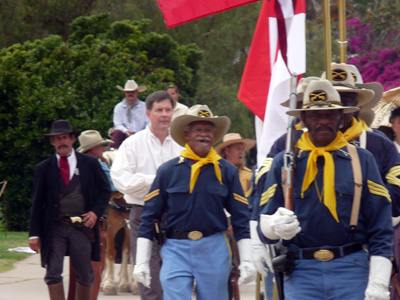
By Donald H. Harrison

SAN DIEGO – The Cosmopolitan Hotel with 10 boutique hotel rooms in Old Town San Diego Historic State Park was rededicated on Saturday with cannon fire, a parade including a present day Marine color guard, historic Buffalo Soldiers re-enactors, costumed Old Town docents, and representatives of various faith groups that were present during Old Town San Diego’s 19th century heyday.
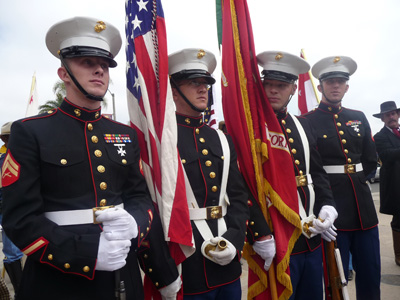
The historic hotel combined the ground floor adobe home built in San Diego’s Mexican period by Don Juan Bandini, an immigrant from Peru, and an upstairs wooden hotel structure built on top of the adobe home by Alfred M. Seeley, an American entrepreneur who operated stables and a stage coach line between San Diego and Los Angeles.
Speeches by faith group members were coordinated by Navy Chaplain David Hart, who had representatives of the Roman Catholic, Episcopal, Mormon and Jewish faiths on hand to tell about their groups’ historic experiences in Old Town.
Because it was Shabbat, rabbis were unavailable to participate in the ceremony, resulting in organizers turning to me as a lay member of the Jewish community familiar with Old Town history. Timothy Evans, the Mormon elder who directs the Mormon Battalion Visitors Center adjacent to the Old Town park provided historic garb for the presenters in keeping with the occasion. My 9-year-old grandson, Shor, who recently completed 3rd grade at Soille San Diego Hebrew Day School, served as this publication’s photographer for the parade and oratory.
Following is the text of my comments about the Jewish community of Old Town San Diego:
**
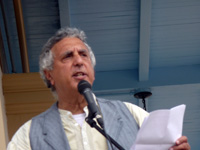
In re-dedicating the Cosmopolitan Hotel, we are bringing back into public service a meeting place for the people of various cultural backgrounds who lived and visited in San Diego during the 19th century. Among such peoples were my own ethno-religious group, the Jews, whom I am proud to represent at these ceremonies.
The first Jew to settle in San Diego was the merchant Louis Rose, who came in 1850. He had many businesses but his first was a small hotel and saloon located on Juan Street in what is now the Fiesta de Reyes. It was one of the first places travelers on horseback would notice coming from Los Angeles. Other Jews followed throughout the early period of American rule in San Diego, among them the Mannasse Brothers – Joseph and Hyman—and their cousin Moses Mannasse. Like Rose they also were merchants. They had immigrated to California from Prussia.
Joe Mannasse and his partner Marcus Schiller also built their business on Juan Street, but you could enter their store from the small street that parallels the Plaza and Juan Street – a street which in its day was called Avenida de Judios – the Avenue of the Jews—in recognition of the fact that Louis Rose, Joseph Mannasse, Marcus Schiller, and other Jewish merchants had a concentration of their businesses there. Today this alleyway connects the Cosmopolitan Hotel with the main part of the Fiesta de Reyes. It would be fitting someday for that name of street to be commemorated.
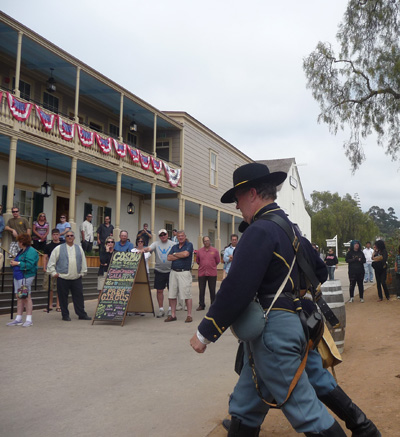
At one time or another, Rose, Mannasse and Schiller all served on the City Board of Trustees – and in those days, city trustees simultaneously served as members of the County Board of Supervisors. Rose, for whom Rose Canyon, Roseville and the Robinson-Rose House – across the plaza – were all named, served on the very first County Board of Supervisors in 1853. Joseph Mannasse served on the city board of trustees that voted in 1867 to hold the auction at which Alonzo Horton bought the land that he turned into downtown San Diego. And Marcus Schiller later in 1867 was on the board that voted to set aside some 1,400 acres of parkland for what became Balboa Park.
Moses Mannasse operated a store in the Robinson Rose building. Hyman Mannasse had his general store in a portion of this very building that we re-dedicate. His partner was a Los Angeles businessman named Jacob Elias , who was a leader of the Jewish community in that city.
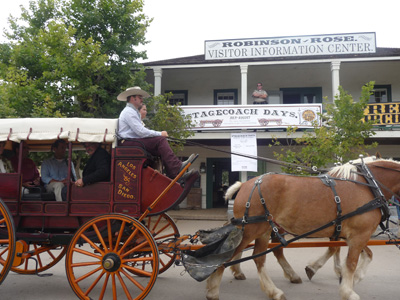
You’d think that inasmuch as they were all related, the Mannasses would have worked together – but you might say that Hyman and Joseph had a bad case of sibling rivalry.
Some of the goods that Hyman sold at this store were the same kinds of goods as Joseph sold at his store. Almost invariably, Hyman sold his goods more cheaply than Joseph – he apparently took delight in undercutting his brother. For example, when Joseph sold calico at 25 cents a yard, Hyman sold it at 20 cents. Joseph sold cravats for $3, Hyman sold them for $1. One of the few items on which they agreed was the Spanish shawl known as a rebozo. They both sold rebozos for $4.
How could Hyman sell items so much cheaply than Joseph? There are several theories in the absence of real facts. It is possible that Jacob Elias was able to purchase goods for the Los Angeles and San Diego markets, perhaps earning a volume discount. Another possibility was that Joseph was selling higher quality merchandise than Hyman; that Hyman was selling “seconds” or used materials. Or it’s possible that Hyman was so determined to outsell his brother, that he was willing to take a loss.
The two brothers both fell in love with the same woman. Hyman was the first to win the heart of Hannah Schiller – who was the sister of Joseph Mannasse’s partner, Marcus Schiller – but he didn’t stay married to her long. He went off to Arizona on a cattle run, leaving Hannah dependent upon her brother and upon Joe Mannasse. After she divorced Hyman, Hannah married Joseph.
We know that Hyman eventually started a business in Arizona, taking as a partner for a brief while a member of Arizona’s famous Goldwater family. In 1875, Hyman’s life came to an end when he was gunned down in his store in Wickenburg during the course of a hold up. Apparently Hyman and Joseph never had the chance to reconcile before the homicide.
As for cousin Moses, he eventually moved to the San Pasqual area – near today’s Wild Animal Park—and started up a business there.
For merchants, San Diego was something of an economic outpost. Typically they had to purchase their goods on credit from wholesalers in San Francisco, and then, because money was scarce, extend credit to the ranchers and townspeople who came into their stores to buy not only cloth and clothing, but such other items as chocolate, cinnamon, clothesline, combs, corn, corn meal, marbles, mugs, onions, cigar paper, pen holders, scissors, shoes, soap, sugar, syrup, tobacco, tooth brushes, window sashes and yeast powder.
Currency was very scarce in California, and often the merchants had to accept payment in cattle, or in crops, and then try to figure out a way to resell such goods. Joseph Mannasse received so much cattle in payment for his goods, that he decided he needed a ranch to keep them all. He and Marcus Schiller ended up purchasing Rancho Encinitas.
During this time, Jews typically held prayer services in each other’s homes, or in buildings like the Cosmopolitan Hotel, or the Franklin Hotel, or the Robinson-Rose House. They gave their informal congregation the Hebrew name of Adat Yeshurun – which means “the gathering of the faithful”—and continued on that basis until 1889 when they inaugurated the first synagogue – which was given the Hebrew name, Beth Israel, meaning the house of Israel. Joe Mannasse’s longtime business partner, Marcus Schiller, was Beth Israel’s founding president.
Although the temple’s first home was at Second and Beech Street in the downtown area, today you can see the temple in Heritage Park, where it was relocated as part of a campaign to Save Our Heritage.
It’s an honor to be with you today and to tell you a little bit about the Jewish history of our city. Thank you.
*
Harrison is editor of San Diego Jewish World . Shor Masori will be a fourth-grade student in September.